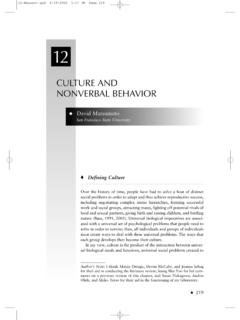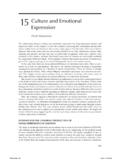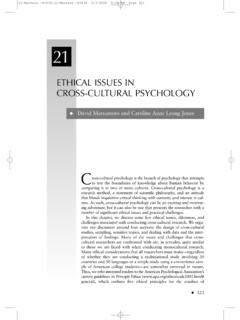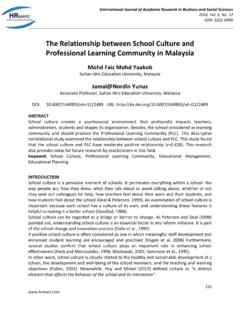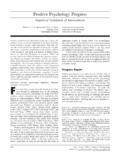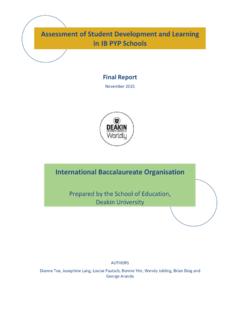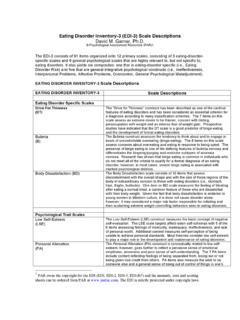Transcription of j Ethnic Differences in Affect Intensity, Emotion ...
1 IMotivationandEmotion, , ,1993jEthnicDifferencesinAffectIntensity ,EmotionJudgments,DisplayRuleAttitudes, ,ifnotall, is importanttoaddressquestionsofcross-cultu ralsimilaritiesanddifferencesviathetesti ngofbetween-countrydifferences, , ,Americansubjectswereselfclassifiedintoo neof fourethnicgroups,andprovideduswithdataco ncerningaffectintensity,displaynileattit udes,self-reportedemotionalexpression,em otionlabeling, ,displayniles,andself-reportedemotionale xpressionsasa researchgrantfromtheNationalInstituteofM entalHealth(MH42749-01),andbya facultyawardforCreativity,Research, wouldliketothankAndreaChangforherassista nceinthedatacollection;KenKokkaforhisedi torialassistanceonanearlierversionofthis manuscript.
2 AndMasamiKobayashi,DeborahKrupp,MijaLee, ErikaManiatis,andBillRoberts,fortheiraid onanearlierversionofthisarticle, ,includingrequestsforreprints,toDavidMat sumoto,DepartmentofPsychology,SanFrancis coStateUniversity,1600 HollowayAvenue,SanFrancisco, $ (j) (1972)andFriesen's(1972)earlystudyonemot ionalexpression,forexample,documentedhow thedisplayofemotiondiffersacrosscultures , ,AmericanandJapanesesubjectsviewedhighly stressfulfilmsfirstalone,andthena secondtimeinthepresenceofa ,membersofbothculturesdisplayedexactlyth esamefacialexpressionsofdisgust,anger,sa dness, ,however,theirexpressionsdiffereddramati cally, ,Matsumoto(1990)surveyeddisplayrulesinth eUnitedStatesandJapanbyobtainingappropri atenessratingsforsixuniversalfa-cialexpr essionsinfivesocialsituations(alone,with ingroups,withoutgroups,withhigher-status others,andwithlower-statusothers).
3 Thereweremanyculturaldifferences,astheJa paneseratedangerandfearmoreappropriateto outgroups,andangermoreappropriatetolower -statusoth-ers, ,however, ,Ekmanetal.(1987) (1990)andMatsumotoandEkman(1989)replicat edandextendedthesefindings, (Matsumoto,1989,1992) (summarizedinScherer,Wallbott,&Summerfie ld,1986;andWallbott&Scherer,1986) (Scherer,Matsumoto,Wallbott,&Kudoh,1988; Matsumoto,Kudoh,Scherer,&Wal1bott,1988), forexample,reportedculturaldifferencesin self-reportedemotionalexpe-rience,includ ingintensity,duration,andcontrolofemotio n;verbalandnonverbalexpressions;physiolo gicalsensationsandreactions; {acialexpressionsofemotionwasnoexception ( ,seeEkman,1972;Ekman,Sorenson,&Friesen,1 969;Ekman&Friesen,1971;EthnicDifferences inEmotion109 Izard,1971).}
4 Inoneofthemostwellknownofthese,forinstan ce,EkmanandFriesen(1971)askedrespondents infivedifferentcountries(theUnitedStates ,Japan,Brazil,Chile,andArgentina)tojudge whichemotionwasbeingshownina isimportanttoaddressquestionsofcross-cul turalsimi-laritiesanddifferencesviathete stingofbetween-countrydifferences,weneed tobeconcernedwithpossibleculturaldiffere nceswithincountries, ,andwhatlittledoesexistis bythistimequitedated( ,Vinacke,1949;Vinacke&Fong,1955).Testing within-countrycul-turaldifferenceswouldb erelativelyeasytodo,especiallyina fartoosimplisticviewofthenatureofculture thatwaspresentinmuchofthepreviouscross-c ulturalresearchonemotion(myownincluded). Operationalizingculturebycountryhasbeenc onvenient, ,thereisanimplicitassumptionthattheindiv idualscomprisinga samplefroma countryarerelativelyhomo-,geneouswithres pecttoeachother,butrelativelyheterogeneo uswithre-specttotheindividualscomprising a "handled"statistically,becauseparametric statisticstestinggroupdifferences( ,analysisofvariance)testbetween-countryv ari-abilityrelativetothevariabilitywithi nthe'Countries;ofcourse,conclu-sionsconc erningcultural( ,country) raise,however, countrywouldcontributetoourconceptualund erstandingofcul-ture,andtobetween-andwit hin-countryculturalinfluencesonemotion.
5 , Suchanassessmentwouldforceustobegintothi nkaboutnewdefinitionsofculturethatwouldb emoremeaningfulthancountrylabelsandtheas -:sociatedstereotypes,impressions,oranec dotesthatmaybecommonlyused, , !,.j'I";!iIr'III,~II1 .Ir,if~1110 Matsumotoit,studies,bothcross-culturalan dnot, ( ,includingonlyEuropeanAmericansinthesamp le).Theexperimentalcontrolaffordedbyther elativeethnichomogeneityinthesampleisa "American" , ,iftherereallyweresystematicculturaldiff erencesinemotionwithinanAmericansample,t heaggregatedgroupdatawouldbeuninterpreta blebecauseonewouldneverbesurewhatwasbein gcompromisedinthedataset, ,forcingresearchersbasicallytochoosebetw eena differenceswereobtained,wecouldthendevis estrategiestodealappropriatelywiththemin ourresearch, ,thenwecouldarriveatmoreappropriateconcl usionsconcerningbetween-countryculturald ifferences, ,theformaltestingofculturaldifferenceson emotionwouldallowforthedataderivedfromsu cha ,however,somepotentialpitfallstothisende avor, ,if andwhenfound, ( ,right-wrong,good-bad,superior-inferior. )
6 Etc.)basedonthedocumentationofdifference s,I suggestthattheresearchersdealinginthisar ea,andtheacademiccommunitythatmaybeconsu mersofthere-search, ,ourgoalsatthispointshouldbedescriptivea ndinformative,todealwiththisissueinasval ue-freea ,unfortunatelythereisnomethodavailableat presenttoclassifyindividualsaccordingtom eaningfuligI~~t,I,, ,wehavechosentostudypossibleculturaldiff erencesviaethnicdifferences, ,Americansubjectswereself-classifiedinto oneoffourethnicgroups(Caucasian,Black,As ian,orHispanic). ,theyprovideduswithdataconcerningaffecti ntensity,displayruleattitudes, ,theyprovideduswithdataconcern-ingjudgme ntsofemotion, considerablenumberofstudiesthatprovideso mebasisforsuggestingdirectionalhypothese soneachofthesedependentvariables, theoreticalorempiricalrationaleforpositi ngdirectionaldifferencesinvolvingallfour ethnicgroupshere,thisstudytestedthenondi rectionalhypothesesthat(1)affectintensit y,(2)degreeofagreementinemotionlabeling, (3)intensityratings,(4)displayruleattitu des,and(5) ~,I.
7 1 METHODS ubjectswererecruitedfromintroductorypsyc hologyclassesata ma-jorurbanuniversityintheSanFranciscoBa yarea, (ap-proximately200) ,orwhocouldnotidentifythemselveswithinon eoffourmajorethnicgroups, (55males,69females)students,allofwhomwer ebornandraisedintheUnitedStates, ,21asBlack,46asAsian, "Caucasian"and"B-Iack"areEumpean-America nandAfrican-American, , , !IiJ,~!112 Matsumoto~Asdiscussedbrieflyintheintrodu ction, ,however, validandreliablemeasureofcultureisavaila ble, ,however,ofaddressingpossibleethnic/cult uraldifferenceswithincountries, ,thefourethniclabelsclearlyrefertogenera lizedcate-gories, ,subjectswhowereChinese,Japanese, ,,weconsideredthelarger, , ,however,wouldbeanacceptabletypeofTypeII error.
8 ,i!,IPresession:AffectIntensity!'iiPrior tothefirstsession,subjectscompleteda demographicquestion-naire,theEysenckPers onalityInventory(includedforthepurposeso fanotherstudy-Matsumoto,1993),andtheAffe ctIntensityMeasure(AIM;Larsen&Diener,198 7).Thismeasureassessestheintensityoftypi -calemotionalexperiencesusinga , andIIcamefromMatsumotoandEkman's(1988)Ja paneseandCaucasianFacialExpressionsofEmo tion(JACFEE).TheJACFEE includeseightphotoseachofsevenemotions(a nger,contempt,disgust,fear,happiness,sad ness,surprise),for'7hemeasurement{)fethn icityandracethemselvesisnoteasy, (1990) ;andfourphotosareposedbyJapanese( ).Eachposercontributedonlyonephototothee n-!tireset; (r=91)usingEkmanandFriesen's(1978)Facial ActionCodingSystem(FACS),ensuringthatbot hthetypeandintensityofthefacialmusclemov ementsineachexpressioncorrespondtothoseo ftheuniversalemotions(Ekman&Friesen,1975 ).}
9 Otherstudiesusingthesephotoshavereported highagreementinsubjects'interpretationso ftheemotionportrayed(Matsumoto,1986;Mats umoto&Ekman,1989). (Matsumoto,1990;Matsumoto&Hearn,1992).Fo urteenoftheJACFEE photoswereused,includingtwophotos(oneCau casianmale,oneCaucasianfemale) ,andina ,subjectsratedtheappropriatenessofeachex pressionineightsocialsituations:alone,in public,withclosefriends,withfamilymember s,withcasualacquaintances,withpeopleofhi gherstatus,withpeopleoflowerstatus, ,sub-jectsuseda 9-pointscale(0to8)labelednotatall(0),a little(1),moderately(4),andverymuch(8).N omentionofemotiontermswasmade, ,theyviewedandratedthetwoexamplesofthene xtemotion, ,subjectsratedhowfre-quentlytheythemselv esdisplayedtheexpression,usinga 5-pointscalerangingfrom0(never)to4(alway s).
10 Subjectsprovidedtheseratingsforallemotio ns., ,.~,~~'ii,SessionII:JudgmentsofEmotionII I!tSessionIIoccurred1 weekafterSession1. , ,for10seceach,ina ,subjectschosea singletermfromalistofseven(anger,[~."f~~ ~[i!~ ,disgust,fear,happiness,sadness,andsurpr ise) ,subjectssawthestimuliagain(samerandomor der)andratedtheintensityofeach,usinga 9-pointscale(0to8)labelednotatall(0),a little(1),a moderateamount(4),anda lot(8).~~; ;however,sucha stimulussetdoesnotexist,andintheabsenceo fsucha set,thepresentationofthebiracialJACFEE wasdeemedbetterthana ,accordingtothestandardscoringprocedure( seeabove). (sevenscores)andsocialsituation(eightsco res) , ,andsecondviaanalysisofvariance(ANOVA)af terrecodingthenominaljudgmentsintorecogn itionaccuracyscores( ,0=emotionnotintended;1=emotionintended) .]]




